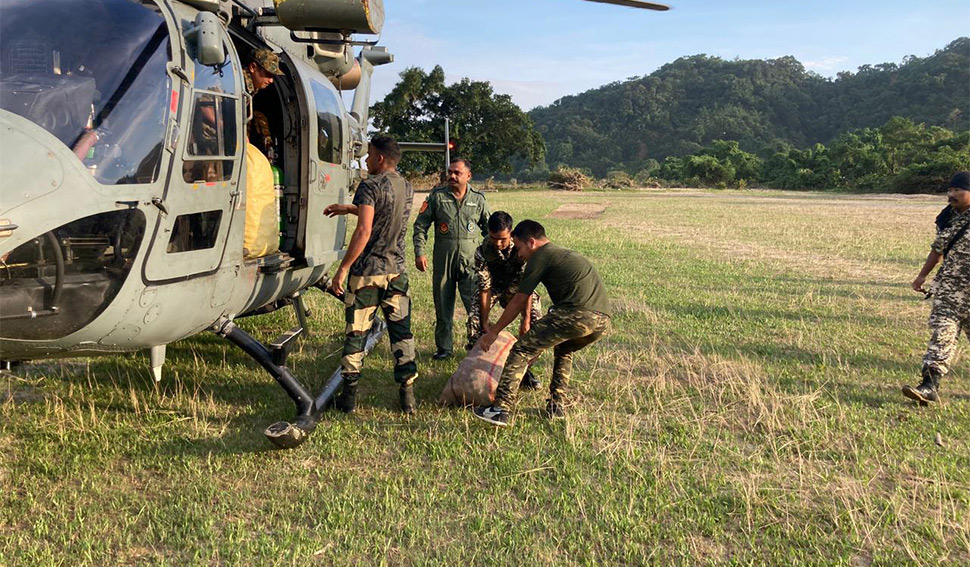Eastern Air Command Indian Air Force: The First Responder and Saviour of North East
The Indian Air Force is celebrating its 91st anniversary on 8 October 2023. The Indian Air Force was officially established on 8 October 1932. The Indian Air Force is divided into 7 Commands. Headquartered at Upper Shillong, the Eastern Air Command is one of the lethal arms of the Indian Air Force. Eastern Air Command (EAC) controls air operations over a vast area that straddles 12 states. It includes the seven north eastern states, Sikkim, West Bengal, Bihar and parts of Orissa and Jharkhand covering over three lakh square kilometres. The area of responsibility includes a 6300 km long international boundary with China, Nepal, Bhutan, Myanmar and Bangladesh. The present Air Officer Commanding in Chief (AOC-in-C) of the Eastern Air Command is Air Marshal SP Dharkar.
The Eastern Air Command was named No. 1 Operational Group at the time of its inception on 27 May 1958 when it was based at Ranikutir in Kolkata as a part of the Government’s increasing emphasis on defence of the Eastern borders. The Operational Group was upgraded as Command on 01 December 1959 with headquarters at Fort William, Kolkata and Air Vice Marshal KL Sondhi as the first Air Officer Commanding-in-Chief of the Eastern Air Command. After 1962 Indo-Chinese War, the decision was made to raise a full-fledged Command at Shillong. “Samareshu Parakram” (Valour in Battle) is the motto of EAC and this propels it to accept all challenges that come on the way to victory. The Air Command employs varied IAF assets such as state of the art fighter aircraft, transport aircraft and helicopters apart from numerous ground based weapon and support systems to ensure air security of the eastern region. The assets are maintained in high state of readiness to tackle any eventuality and regular exercises are undertaken to ensure retention of combat edge. Also, aircraft are regularly deployed to assist civil administration during any natural calamities, regular transit for citizens residing in remote areas and for casualty evacuation.
The command has three broad spheres of activities – operations, maintenance and administration. In some cases, the pilots operate from the Advance Landing Grounds (ALG) with only one third of the length of a regular runway, having unique and unidirectional approach and take-off requirements. This coupled with the vagaries of weather expects superior skills from the pilots and their navigators. Both humans and machine are stretched to the limits of their capabilities.
The Indian Air Force (IAF) has been undertaking Humanitarian Assistance and Disaster Relief (HADR) missions at a short notice to rescue our citizens in North East during various contingencies. The spectrum of these relief operations is enormous and is entirely based on the dynamic situation that emerges as an effect of calamities like large scale flooding, earthquake, localised rail or road disruption, hostile developments in the internal security scenario, shortfall of essential commodities or at times even an isolated case of stranded tourists. IAF always emerges as a first responder and a saviour by establishing a bridge of relief and assistance through air. All its aircraft and helicopters are tirelessly into action 24 x 7 and are deployed in the crisis area as per the demands of the situation. It is akin to a ray of hope from the sky amidst the dark clouds of helplessness and uncertainty.
The North Eastern regions of India is not only the most beautiful and ecological sensitive sector in the country but also one of the most vulnerable and disaster-prone areas as well. The intensity and frequency of disasters such as floods and earthquakes have only increased in the last decade, often leaving large numbers of people in need of humanitarian assistance. Further, the growing vulnerability to natural disasters can be associated with factors such as population growth, urbanisation, industrialisation, environmental degradation and climate change.
Although there are multiple agencies involved in any humanitarian operation, but round-the-clock close coordination for HADR in NE is ensured essentially between IAF, Indian Army, Border Roads Organisation, National Disaster Response Force (NDRF), State Disaster Management Authority (SDMA) and Airports Authority of India (AAI). All the critical decisions are taken in consultation with each of these agencies. This coordination and planning behind the scenes paves the way forward for the action on the field that ensures overall mission success.
For instance, last year in May – Jun 22, IAF had to undertake immediate and large scale HADR mission to airlift people from flood affected regions in Assam and Meghalaya as well as rescue passengers from stranded railway stations in Assam. Unusually heavy rainfall in the Dima Hasao region had resulted in landslides, damaged roads, railway bridges and waterlogging over the railway lines creating havoc and disrupting normal life.HADR operation was launched on 15 May 22 and IAF flew more than 100 sorties in next few days on An-32s, ALHs, Mi-17s and Chinooks. The relief material was airlifted from Guwahati and Johrat to Silchar by An-32s. The supplies were thereafter airlifted by Mi-17s and Chinook helicopters initially to Haflong and in later days to villages affected by floods viz Khepre, Hajadisha, Laisong, Harangajao and Hajaichak. IAF had airlifted more than 300 passengers & dropped/carried 5,00,000 kg of relief material for Assam & 21,000 Kg for Meghalaya.
A total of 474 people were rescued from inhospitable areas and brought to safety while nearly 75000 kg of relief supplies including food items and diesel were air supplied to far flung villages, providing much-needed immediate relief to the affected people. An aerial reconnaissance of power lines by helicopter was also undertaken to ensure quick assessment and restoration of power supply to affected areas. In Oct 2022, ‘Cyclone Sitrang’ was headed towards NE India and Tripura in particular. IAF airlifted five NDRF teams with 24 tonnes of specialised HADR equipment to Agartala in C130J ‘Super Hercules’ aircraft throughout the night amidst heavy rains.
IAF proudly stands to its commitment of being the first responders and saviours of NE. IAF is steadfast in its pursuit of excellence in terms of ‘Har kaam, Desh ke Naam’ and its indomitable resolve that is defined by IAF motto ‘To touch the sky with glory’. The Eastern Air Command was born in combat and has grown through battles .One of the lethal arms of the Indian Air Force; Eastern Air Command (EAC) controls air operations over a vast area. And it will continue to be a shining star among all the Commands as it safeguards the eastern frontiers of this great nation.
As the mighty Indian Air Force celebrates its anniversary, Air Officer Commanding in Chief (AOC-in-C) of the Eastern Air Command Air Marshal SP Dharkar exhorted the Air Warriors to make the best use of the resources and to continue to work towards taking the IAF and the nation to greater heights and glory …“Touch the Sky with Glory “. Contributed


Leave a Reply